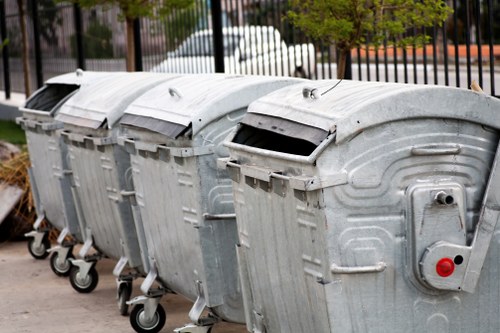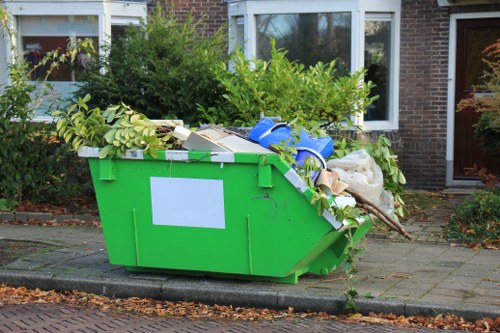Builders Waste Clearance in Furniture Disposal

In the world of construction and renovation, effective waste management plays a crucial role in maintaining cleanliness and ensuring safety on-site. One aspect often overlooked is the proper clearance of builders' waste during furniture disposal. Efficient waste clearance not only contributes to a cleaner environment but also enhances the overall efficiency of the project.
Builders waste clearance involves the systematic removal and disposal of materials leftover from construction or renovation projects. This includes items like broken furniture, discarded materials, and other debris that accumulate during the building process.
Proper disposal of builders' waste is essential to prevent hazards, reduce environmental impact, and comply with local regulations. It ensures that the workspace remains organized and free from unnecessary clutter, which can impede progress and pose safety risks.
Why Builders Waste Clearance is Essential

Managing builders' waste effectively is not just about maintaining aesthetics; it has several practical benefits that are vital for any construction project.
Safety: Accumulated waste can create hazardous conditions, leading to accidents and injuries. Sharp objects, broken materials, and unstable piles can pose significant risks to workers.
Efficiency: A clutter-free site allows for smoother operations and easier movement of machinery and personnel. It minimizes delays and enhances productivity.
Environmental Impact

Improper disposal of builders' waste can have detrimental effects on the environment. Materials that are not recycled or disposed of correctly can contaminate soil and water sources.
Implementing sustainable waste clearance practices, such as recycling and reusing materials, reduces the environmental footprint of construction projects. It also aligns with global efforts to promote sustainability and responsible resource management.
Additionally, reducing waste contributes to the conservation of natural resources, ensuring that construction projects become more eco-friendly and sustainable.
The Process of Builders Waste Clearance

The process of builders waste clearance involves several steps to ensure efficient and environmentally responsible disposal.
Assessment: The first step is to assess the type and volume of waste generated. This helps in planning the disposal methods and determining the resources needed.
Segregation: Sorting waste into different categories, such as recyclable, non-recyclable, and hazardous materials, is crucial for effective disposal.
Collection and Transport

Once segregated, the waste is collected and transported to appropriate disposal facilities. Choosing the right transportation methods is essential to minimize environmental impact and ensure compliance with regulations.
Disposal: Proper disposal involves taking the waste to designated landfills or recycling centers. In some cases, repurposing materials can further reduce waste.
Implementing efficient waste clearance strategies ensures that builders' waste is managed responsibly, reducing the strain on the environment and promoting sustainable construction practices.
Challenges in Builders Waste Clearance

Despite its importance, builders waste clearance faces several challenges that can hinder effective management.
Lack of Awareness: Many construction companies are not fully aware of the best practices for waste management. This lack of knowledge can lead to ineffective disposal methods and increased environmental impact.
Regulatory Compliance: Navigating the complex web of local and national regulations regarding waste disposal can be daunting. Non-compliance can result in hefty fines and project delays.
Cost Factors

Effective waste clearance requires investment in proper tools, transportation, and disposal services. For some projects, especially smaller ones, the costs associated with waste management can be a significant barrier.
However, investing in efficient waste clearance solutions can lead to long-term savings by reducing the need for extensive cleanup and minimizing the risk of accidents and delays.
Moreover, adopting sustainable waste management practices can open up opportunities for recycling and reusing materials, further cutting costs.
Solutions for Effective Builders Waste Clearance

Overcoming the challenges of builders waste clearance requires a combination of strategic planning, investment in the right resources, and adherence to best practices.
Education and Training: Providing training to construction workers on proper waste management techniques ensures that everyone is on the same page and committed to maintaining a clean site.
Regulatory Compliance: Staying informed about local and national waste disposal regulations helps in avoiding fines and ensures that the project adheres to legal standards.
Adopting Technology

Utilizing technology can greatly enhance the efficiency of waste clearance processes. Tools like waste management software can help in tracking waste generation, scheduling pickups, and ensuring compliance with disposal regulations.
Additionally, investing in machinery that aids in the segregation and transportation of waste can streamline the entire process, making it more efficient and less labor-intensive.
Embracing technological advancements in waste management can lead to significant improvements in both efficiency and environmental sustainability.
Benefits of Proper Builders Waste Clearance

Implementing effective builders waste clearance strategies offers numerous benefits that extend beyond maintaining a clean site.
Environmental Sustainability: Proper waste management reduces the environmental impact of construction projects by minimizing pollution and conserving resources through recycling and reuse.
Cost Savings: Efficient waste clearance can lead to cost savings by reducing the amount of waste that needs to be disposed of and by repurposing materials for future use.
Enhanced Reputation

Construction companies that prioritize waste management demonstrate their commitment to sustainability and social responsibility. This can enhance their reputation, making them more attractive to clients who value environmental stewardship.
Building a reputation for responsible waste management can also lead to increased business opportunities and long-term client relationships.
Moreover, it positions the company as a leader in the industry, promoting best practices and encouraging others to follow suit.
Best Practices for Builders Waste Clearance

To ensure effective builders waste clearance, adopting best practices is essential. These practices not only facilitate efficient waste management but also promote sustainability.
Waste Minimization: Reducing the amount of waste generated in the first place is the most effective way to manage it. This can be achieved through careful planning, efficient use of materials, and adopting lean construction techniques.
On-Site Segregation: Separating waste at the source simplifies the recycling and disposal process. It ensures that recyclable materials are not contaminated and can be effectively processed.
Regular Audits

Conducting regular audits of waste management practices helps in identifying areas for improvement and ensuring compliance with regulations. These audits can track waste generation, evaluate the effectiveness of disposal methods, and measure progress towards sustainability goals.
By continuously monitoring and assessing waste management practices, construction projects can adapt and implement changes that enhance efficiency and reduce environmental impact.
Regular audits also help in maintaining accountability and ensuring that waste clearance strategies are being followed consistently.
Choosing the Right Builders Waste Clearance Service

Selecting a reliable waste clearance service is critical for effective waste management. The right service provider can streamline the disposal process, ensure compliance, and contribute to overall project success.
Experience and Expertise: Look for companies with a proven track record in builders waste clearance. Their experience ensures they understand the complexities of construction waste and can handle it efficiently.
Comprehensive Services: A good service provider should offer a range of services, including waste collection, transportation, recycling, and disposal. This ensures that all aspects of waste management are covered.
Cost-Effectiveness

While cost should not be the sole factor in choosing a waste clearance service, it is an important consideration. Compare different providers to find one that offers quality services at competitive rates.
Additionally, consider the long-term benefits of investing in a reliable service provider. Efficient waste management can lead to cost savings through reduced disposal fees and minimized project delays.
Choosing the right service provider ensures that waste clearance is handled professionally, allowing the construction team to focus on their core activities.
Conclusion

Builders waste clearance in furniture disposal is an integral part of successful construction and renovation projects. It ensures a safe, efficient, and environmentally responsible approach to managing waste generated on-site.
By implementing effective waste management strategies, adhering to best practices, and choosing the right service providers, construction companies can enhance their project outcomes, reduce environmental impact, and maintain a positive reputation in the industry.
Contact us today to learn more about our builders waste clearance services and how we can help your construction project stay clean, safe, and sustainable.